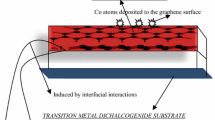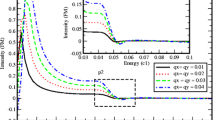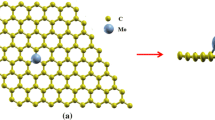Abstract
A model of the energy diagram is proposed for graphene (Gr) monolayer formed on a magnetic transition metal (MTM). The regimes of the strong and weak Gr–MTM coupling are considered; the analytical expressions have been derived for the magnetization induced by a substrate in epitaxial graphene in these regimes. It is shown that, in the strong coupling regime, a quasi-local state gives the main contribution to the magnetization; in this case, the coupling has an antiferromagnetic character. In the weak coupling regime, the main contribution to the magnetization is given by states of the d band of MTM, which leads to the ferromagnetic character of the coupling. The numerical estimations are performed for the Gr/Ni(111) and Gr/Co(poly) and they are compared with the experimental data for Gr/Ni(111) and the calculated results for Cr/Co/Ni(111). In the first case, the results agree quantitatively and, in the second case, qualitatively.

Similar content being viewed by others
REFERENCES
M. Fujita, K. Wakabayashi, K. Nakada, and K. Kusakabe, J. Phys. Soc. Jpn. 65, 1920 (1996).
T. L. Makarova, Semiconductors 38, 615 (2004).
E. Kan, Z. Li, and J. Yang, Nano 3, 433 (2006).
K. S. Novoselov, A. K. Geim, S. V. Morozov, D. Jiang, Y. Zhang, S. V. Dubonos, I. V. Grigorieva, and A. A. Firsov, Science (Washington, DC, U. S.) 306, 666 (2004).
Y.-W. Son, M. L. Cohen, and S. G. Louie, Nature (London, U.K.) 444, 347 (2006).
V. Barone, O. Hod, and G. E. Scuseria, Nano Lett. 6, 2748 (2006).
O. V. Yazyev, Rep. Prog. Phys. 73, 056501 (2010).
V. Meunier, A. G. Souza Filho, E. B. Barros, and M. S. Dresselhaus, Rev. Mod. Phys. 88, 025005 (2016).
M. Slota, A. Keerthi, W. K. Myers, E. Tretyakov, M. Baumgarten, A. Ardavan, H. Sadeghi, C. J. Lambert, A. Narita, K. Müllen, and L. Bogani, Nature (London, U.K.) 557, 691 (2018).
S. Yu. Davydov, Phys. Solid State 62, 223 (2020).
O. V. Yazyev, W. L. Wang, S. Meng, and E. Kaxiras, Nano Lett. 8, 766 (2008).
J. J. Palacios, J. Fernández-Rossier, and L. Brey, Phys. Rev. B 77, 195428 (2008).
H. Kumazaki and D. Hirashima, Phys. E (Amsterdam, Neth.) 40, 1703 (2008).
W. Li, M. Zhao, Y. Xia, R. Zhang, and Y. Mu, J. Mater. Chem. 19, 9274 (2009).
F. M. Hu, T. Ma, H.-Q. Lin, and J. E. Gubernatis, Phys. Rev. B 84, 075414 (2011).
C. B. Crook, C. L. Constantin, T. Ahmed, J.-X. Zhu, A. V. Balatsky, and J. T. Haraldsen, Sci. Rep. 5, 12322 (2015).
E. Nakhmedov, E. Nadimi, S. Vedaei, O. Alekperov, F. Tatardar, A. I. Najafov, I. I. Abbasov, and A. M. Saletsky, Phys. Rev. B 99, 125125 (2019).
G. Bertoni, L. Calmels, A. Altibelli, and V. Serin, Phys. Rev. B 71, 075402 (2004).
M. Weser, Y. Rehder, K. Horn, M. Sicot, M. Fonin, A. B. Preobrajenski, E. N. Voloshina, E. Goering, and Yu. S. Dedkov, Appl. Phys. Lett. 96, 012504 (2010).
H. Yang, A. D. Vu, A. Hallal, N. Rougemaille, J. Coraux, G. Chen, A. K. Schmid, and M. Chshiev, Nano Lett. 16, 145 (2016).
H. Yang, G. Chen, A. A. C. Cotta, A. T. N’Diaye, S. A. Nikolaev, E. A. Soares, W. A. A. Macedo, K. Liu, A. K. Schmid, A. Fert, and M. Chshiev, Nat. Mater. 17, 605 (2018).
R. Decker, J. Brede, N. Atodiresei, V. Caciuc, S. Blügel, and R. Wiesendanger, Phys. Rev. B 87, 041403(R) (2013).
A. D. Vu, J. Coraux, G. Chen, A. T. N’Diaye, A. K. Schmid, and N. Rougemaille, Sci. Rep. 6, 24783 (2016).
G. S. Grebenyuk, E. Yu. Lobanova, D. A. Smirnov, I. A. Eliseev, A. V. Zubov, A. N. Smirnov, S. P. Lebedev, V. Yu. Davydov, A. A. Lebedev, and I. I. Pronin, Phys. Solid State 61, 1316 (2019).
D. Pesin and A. H. MacDonald, Nat. Mater. 11, 409 (2012).
W. Han, R. K. Kawakami, M. Gmitra, and J. Fabian, Nat. Nanotechnol. 9, 794 (2014).
P. Recher and B. Trauzettel, Nanotechnology 21, 302001 (2010).
S. Yu. Davydov, Semiconductors 47, 95 (2013).
S. Yu. Davydov, A. A. Lebedev, and O. V. Posrednik, An Elementary Introduction to the Theory of Nanosystems (Lan’, St. Petersburg, 2014) [in Russian].
J. Ziman, Principles of the Theory of Solids (Cambridge Univ., Cambridge, 1976; Mir, Moscow, 1974), Chap. 10.
V. Yu. Irkhin and Yu. P. Irkhin, The Electronic Structure, Correlation Effects and Physical Properties of D- and F-Metals and Their Compounds (UrO RAN, Yekaterinburg, 2004; Cambridge International Science Publ., 2007), Chap. 2.
S. Yu. Davydov, Phys. Solid State 58, 804 (2016).
Ch. Kittel, Introduction to Solid State Physics (Wiley, New York, 1995; Nauka, Moscow, 1978).
W. A. Harrison, The Electronic Structure and Properties of Solids (Freeman, San Francisco, CA, 1980).
Physical Values, The Handbook, Ed. by I. S. Grigor’ev and E. Z. Meilikhov (Energoatomizdat, Moscow, 1991) [in Russian].
W. A. Harrison, Phys. Rev. B 27, 3592 (1983).
T. O. Wehling, E. Sasıoglu, C. Friedrich, A. I. Lichtenstein, M. I. Katsnelson, and S. Blügel, Phys. Rev. Lett. 106, 236805 (2011).
V. S. Fomenko, Emission Properties of Materials, The Handbook (Naukova Dumka, Kiev, 1981) [in Russian].
J.-H. Kim, J. H. Hwang, J. Suh, S. Tongay, S. Kwon, C. C. Hwang, J. Wu, and J. Y. Park, Appl. Phys. Lett. 103, 171604 (2013).
A. Mattausch and O. Pankratov, Phys. Rev. Lett. 99, 076802 (2007).
A. H. Castro Neto, F. Guinea, N. M. R. Peres, K. S. Novoselov, and A. K. Geim, Rev. Mod. Phys. 81, 109 (2008).
S. Yu. Davydov, Phys. Solid State 60, 812 (2018).
S. Yu. Davydov, Phys. Solid State 56, 412 (2014).
Author information
Authors and Affiliations
Corresponding author
Ethics declarations
The author declares that he has no conflicts of interest.
Additional information
Translated by Yu. Ryzhkov
APPENDIX
APPENDIX
Consider the problem of adsorption of an individual atom on MTM. In this case, for the density of states, we obtain, instead of Eq. (7), expression
where ε0 is the adatom quasi-level energy, Γσ(ω) and Λσ(ω) are given by Eqs. (4) and (5). Assume that the adatom orbital energy ε0 = 0, which corresponds to the Dirac point. The matter is that here (in the strong coupling regime Γ/t\( \gg \) 1) we consider a pseudo-isolated epigraphene atom, rather than a solitary carbon adatom. The maxima of density of states (A1) correspond to the roots of equation
If inequality 1 < \({{(d{{\Lambda }_{\sigma }}(\omega ){\text{/}}d\omega )}_{{{{\omega }_{{0\sigma }}}}}}\), there is only one root \(\omega _{\sigma }^{*}\) in the region of the continuous spectrum (Fig. 1b). Since dΛσ(ω)/dω = WdΓ/π[(Wd/2)2 – (ω – ω0σ)2], we obtain πWd/4Γ < 1, which is valid for the Gr/Ni(111) system, according to the estimations presented in the text. Assuming that |\(\omega _{\sigma }^{*}\) – ω0σ| \( \ll \)Wd/2, we have Λσ(ω) ≈ –4(ω – ω0σ)Γ/πWd, and, instead of Eq. (A2), we have \(\omega _{\sigma }^{*}\) + 20(Vd/Wd)2(\(\omega _{\sigma }^{*}\) – ω0σ) = 0. Because, according to the abovementioned estimations, 20(Vd/Wd)2\( \gg \) 1, we have \(\omega _{\sigma }^{*}\) ≈ ω0σ. Then, in the vicinity of the maximum, the density of states can be represented as \({{\bar {\rho }}_{\sigma }}(\omega )\) ≈ Γ/π[(ω – ω0σ)2 + Γ2]. Since EF = 0, we obtain the contribution of band states (\({{\bar {n}}_{\sigma }}\))band to the occupation number \({{\bar {n}}_{\sigma }}\) from Eq. (10) as
In the case that |\(\omega _{\sigma }^{*}\) – ω0σ| \( \gg \)Wd/2, we have two solutions of Eq. (A2) corresponding to local levels with energies \(\omega _{\sigma }^{ + }\) ≈ \( \pm {{V}_{d}}\sqrt 5 \) + ω0σ/2. We refine: these levels can be taken to be local only with respect to MTM, since they lie off the dσ subband of a metal (Fig. 1b). Actually, these levels are quasi-local or resonant, since they are overlapping with the continuous spectrum of graphene. However, we will perform estimations assuming their local, since the density of states of MTM is much higher than the graphene density of states (Fig. 1). It is easy to see that this simplification is of the same order as the neglect of the s band of MTM.
The occupation number of level \(\omega _{\sigma }^{ - }\) calculated by formula (\({{\bar {n}}_{\sigma }}\))loc = \(\left| {1 - d{{\Lambda }_{\sigma }}(\omega ){\text{/}}d\omega } \right|_{{\omega _{\sigma }^{ - }}}^{{ - 1}}\) [29] is
The resulting magnetization counted per one epigraphene atom is \(\bar {m}\) = \({{\bar {n}}_{ \uparrow }}\) – \({{\bar {n}}_{ \downarrow }}\), where \({{\bar {n}}_{\sigma }}\) = (\({{\bar {n}}_{\sigma }}\))band + (\({{\bar {n}}_{\sigma }}\))loc. Using Eqs. (A3) and (A4), we obtain Eq. (13) of this report. Since the summary occupation number of epigraphene atom is \(\bar {n}\) = \(\sum\nolimits_\sigma {[{{{({{{\bar {n}}}_{\sigma }})}}_{{{\text{band}}}}}} \) + \({{({{\bar {n}}_{\sigma }})}_{{{\text{loc}}}}}]\), then
where η = Wd/Vd\(\sqrt 5 \). In the framework of the Harrison theory, we have η ≈ 0.63, so that \(\bar {n}\) ≈ 1.04. We emphasize that the local state gives the main contribution to \(\bar {n}\). Since the model energy diagram considered in this work for the Gr/Ni(111) is symmetric with respect to EF = 0 (Fig. 1); the exact value of the occupation number must be 1. Thus, the error is only 4%.
Rights and permissions
About this article
Cite this article
Davydov, S.Y. Magnetization of Epitaxial Graphene Induced by Magnetic Metallic Substrate. Phys. Solid State 62, 378–383 (2020). https://doi.org/10.1134/S1063783420020080
Received:
Revised:
Accepted:
Published:
Issue Date:
DOI: https://doi.org/10.1134/S1063783420020080




